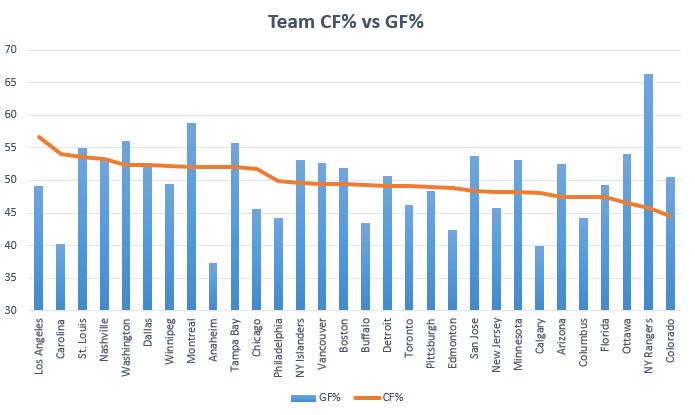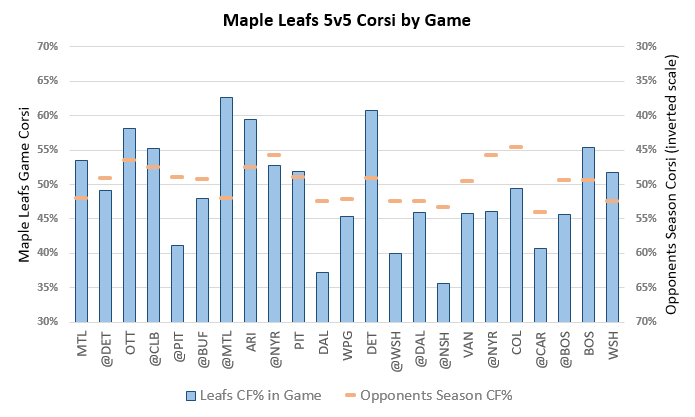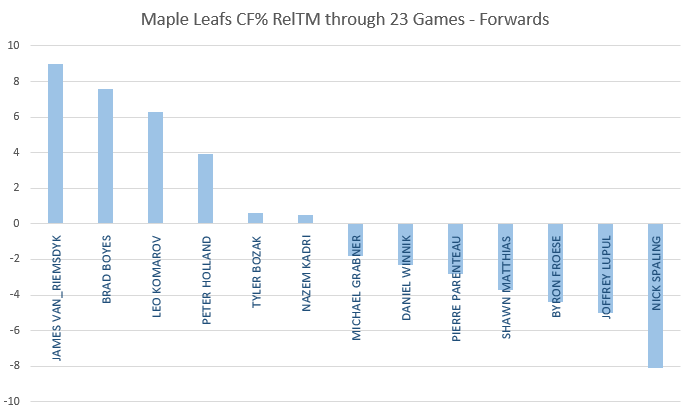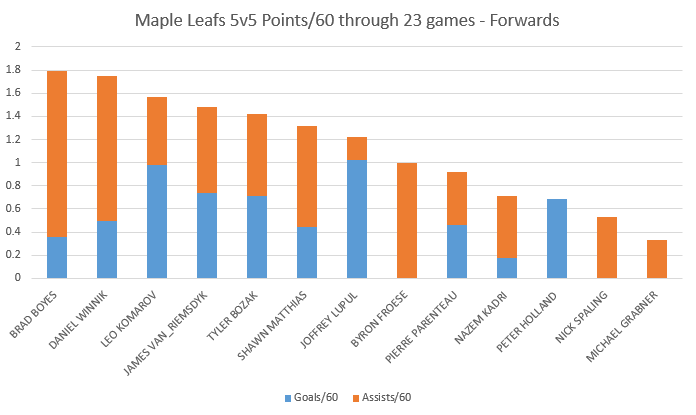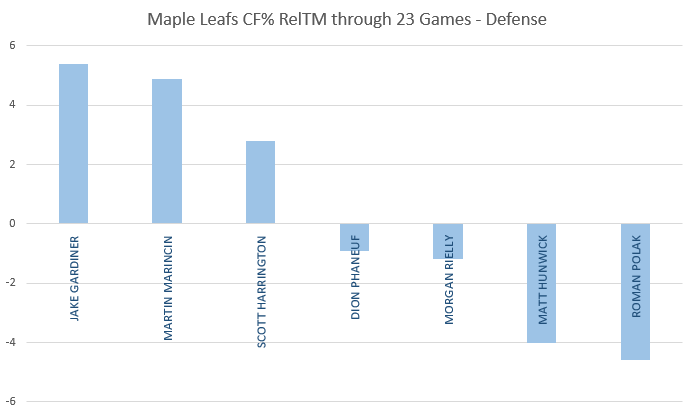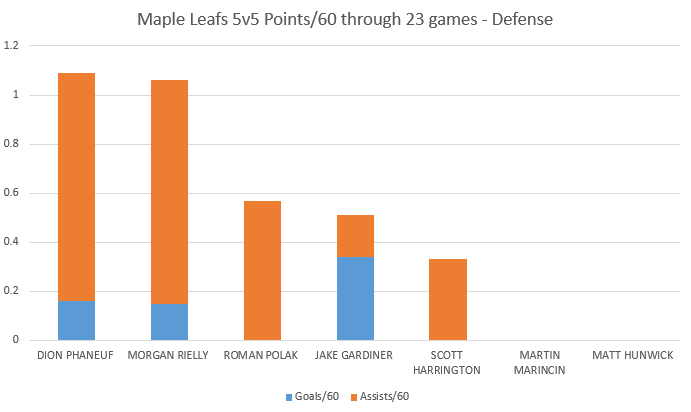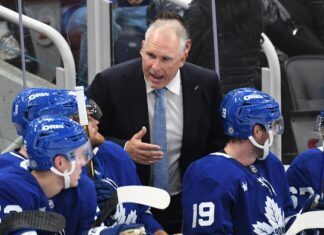A little past the quarter mark of the season, it seems like a good time to take a look at where the Toronto Maple Leafs stand statistically, both at the team and at the player level.
All the statistics I am going to look at today are 5v5 statistics from Puckalytics.com.
How the Leafs Rank in the League
The chart above has teams sorted by their Corsi (CF%, orange line) with their goal percentage (GF%, blue bars) also shown. If you are a believer in PDO being an indicator of luck, generally speaking teams with a blue bar below their orange line would have a lower PDO and be considered unlucky. The opposite would be true for those with their blue bar above their orange line.
The Leafs rank slightly below middle of the pack in both statistics with a 49.1 CF% (18th in league) and a 46.3 GF% (21st in league), which you might consider a little unlucky. I don’t fully buy into this, but there are some teams that are almost certainly lucky (NY Rangers) or almost certainly unlucky (Anaheim). I don’t have enough confidence in the PDO-luck connection to be certain that the Leafs have been unlucky, as their PDO is 99.6, which is within the typical range over the course of a season.
All that said, while they may not be unlucky in goal scoring/prevention, they may be unlucky in converting their GF% into wins. The Leafs have just five regulation or overtime wins (ROW), which puts them on pace to reach about 18 on the season. Over the past two seasons, only Buffalo has had fewer ROW and only a handful had fewer than 25. Based on their GF%, they should be a little better, and I would expect they will end up with more than 18 ROW by the end of the season. They are far from a good team though.
Leafs CF% Game by Game
The above chart shows the Leafs 5v5 CF% in each game they have played this season (blue bars) compared to their opponents 5v5 CF% on the season (orange lines). I have inverted the opponents scale (secondary axis on the right), so the orange lines give an indication of the Leafs are expected to do in the game based on their opponent’s seasonal CF%. There have been 14 games this season where the Leafs failed to reach the CF% that their opponents typically give up and nine times where they exceeded it. Since the second Pittsburgh game, it has been much worse with the Leafs only exceeding expectations in three of 13 games. Interestingly, they were 6-4-3 in those 13 games compared to 1-7-2 in their first 10 when they generally exceeded expectations.
Maple Leafs Forwards
The above chart shows the Leafs forwards (minimum 100 5v5 minutes played) and their CF% RelTM. I am using CF% RelTM because the RelTM statistics are a better indication of individual contribution and a better comparison with players on other teams (it removes some team factors from CF%). As we are looking only at Leaf players, CF% would have worked as well.
James van Riemsdyk leads the team, which is a good turnaround because he has been one of the worst Corsi players in the league the last few seasons. Playing with Komarov and Kadri certainly helps as both are better possession players.
Joffrey Lupul, who had a bit of a Corsi resurgence in the second half of last season when he was playing with Kadri, has fallen on tough times again having been separated from Kadri. Spaling has been his most frequent center, but he has played a fair bit with Froese and Bozak as well. He really isn’t well suited to play with Froese and Spaling as he is best used in an offensive role and those guys can’t provide that.
I think the surprise here is Komarov. He has really produced well since being put on the top line with Kadri and JVR. Kadri’s goal and point production struggles are well documented, but I think it is mostly just bad puck luck. He should get his points eventually. You will also notice that it is a fairly balanced line up, but mostly because there is nobody putting up really elite level numbers. To put these numbers in perspective from 2010-11 to 2014-15, Phil Kessel had a points/60 of 2.39 — 34% better than Brad Boyes this season.
The mystery to me is Michael Grabner — not because of his poor point totals, but because of how he has been used. Grabner has put up excellent Point/60 numbers his whole career and his 1.93 points/60 over the past three seasons is better than any Leaf forward has done this year. He clearly has some offensive ability, but he isn’t getting used in an offensive way at all. It makes no sense to me because he has the offensive talent to put up some decent numbers, in which case, at minimum, you could flip him for a decent draft pick come the trade deadline. A bit of a waste of talent if you ask me.
Maple Leafs Defensemen
Jake Gardiner is once again having a very good season possession-wise. Gardiner has never posted a negative CF% RelTM, and has never been below 4.0 in the past four seasons.
While still a negative CF% RelTM player, Phaneuf has improved quite a bit from the past few seasons. He has benefited from playing a more offensive oriented game and being used less as a pure shutdown defenseman. On the flip side, Hunwick’s statistics suffer from playing more of a shutdown role.
Phaneuf and Rielly have led the Leafs defense in point production. Interestingly, it was a line up change that may have prompted the increased production. Early in the season, Phaneuf was paired with Hunwick in a more defensive role. After netting just one assist during his time with Hunwick, Phaneuf was then moved to a defense pairing with Jake Gardiner. Since that point, Phaneuf has netted a goal and five assists playing with Gardiner.
When Phaneuf and Hunwick were split up, Hunwick was then paired with Rielly, and Rielly has had five of his six points when playing with Hunwick. The Rielly-Hunwick pairing is an interesting combination; it is not completely unlike Phaneuf-Gardiner, although Phaneuf is far more offensively inclined than Hunwick when he is allowed to show it.
There is your statistical look at the Leafs season thus far. It has been a struggle at times without an elite level offensive talent up front like Kessel. There have been some positive developments as well, especially on the back end with some good play from Rielly and Gardiner, as well as Babcock finding a more suitable role for Phaneuf. The longer term hope for the team is that Nylander and Marner can provide the elite level offensive talent they so desperately need. If/when they do, this team will be ready to move to the next level. Until then, it will be a tough grind for whatever success they can obtain.
I’ll re-visit this analysis around the All-Star break to see if anything has changed and also with an eye towards possible trade deadline moves.























